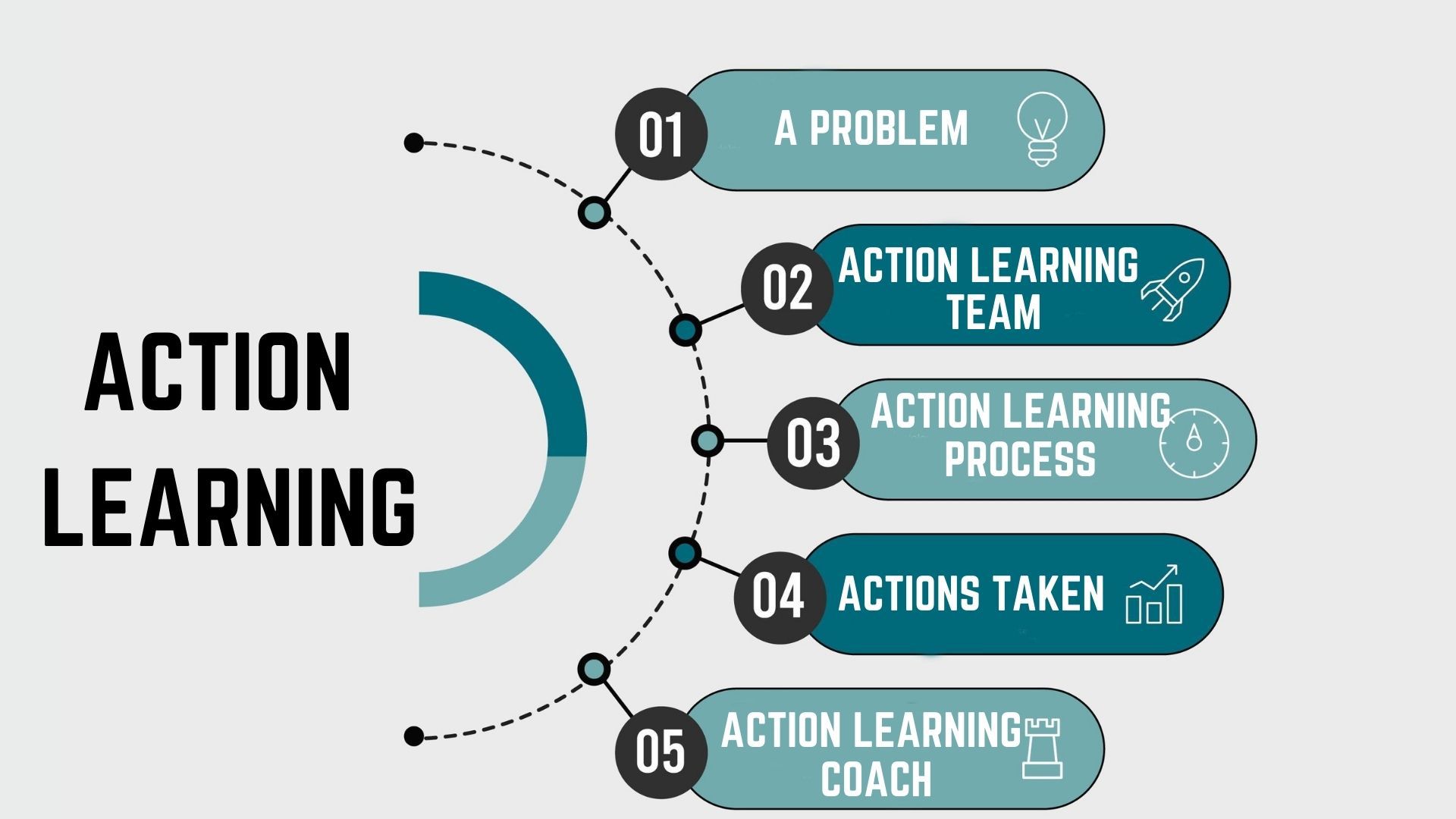Action learning is a process of coming up with creative solutions to deal with or to solve tedious problems faced by an organization, an individual, or a group of people. In action learning, steps are taken to solve the problem, and each step is evaluated to learn about its effectiveness.
Table of Contents
What is action learning?
In simple words, we can say that action learning is a process of learning from your actions. In the action learning process, a step-by-step approach is used to solve the problems faced by an organization or an individual. Each step followed in the process is evaluated to check its effectiveness. The evaluation of each step is done to create a new and efficient solution to solve the problem, and later the solution is put into action.
Action learning is a practical approach to determining the solution for problems as each step is evaluated. Only the effective steps are considered for the action learning process. Because of this reason, the action learning process is regarded as one of the best methods for team learning purposes and as a team’s approach for problem-solving.
Action-learning is adopted by those organizations concerned about developing their employees and the development of the organization.
However, the action learning process is not the same as an action learning project. In an action learning project, a learning project is assigned to the learners’ team, and are asked to put their learning into action. On the other hand, the action learning process involves a problem, a group of peers, or an individual, a step-by-step approach to solve the problem and reflection on each step involved in the learning process.
Professor Reginald Revans introduced action learning. He mentioned that making a small group of people use their knowledge and experience to find a problem is an efficient method for problem-solving and learning. He made use of the action learning process for management development and the revival of many organizations.
How does action learning work?
Action learning is a method to solve organizational problems by using individual skills and leadership skills of individuals. Action learning focuses on developing individuals by providing them a chance to openly speak their minds to offer solutions to the organization’s challenges. In action learning, all the employees are treated the same, and everyone has the same level of contribution to the problem-solving process.
In the action learning process, a group of employees are selected and are asked to hold discussions and are asked to find the solution for the problem at hand. This group of employees is referred to as “set.” The first task for the people of the set is to select a group leader. The group leader is also called the facilitator. The group leader is required to perform specific tasks that make the working of the set properly. The following are the prominent roles played by the facilitator.
- The facilitator is responsible for making all the preparation to conduct a meeting.
- He/she will play the role of an advisor for the other members of the group.
- Structuring the meeting time in a way to get maximum work done.
- Instructing and controlling the members’ participation to avoid altercations and wastage of time.
- Select and design questions in such a way so that the right information can be obtained.
- To provide equal opportunities to everyone to participate in the discussion and provide them with a fair chance to freely present their views.
- Making the list of solutions proposed by members of the set and follow up with them later.
- To perform the role of an intermediary between the organization’s management and the group members.
- To encourage the members to develop creative and innovative ideas and think out of the box.
- To develop a final solution and present the final solution to the organization’s management.
In the improvised version of action learning, it is realized that a facilitator’s role might control the creative thinking process of the members of the set. Therefore, the roles of the group leader are further restricted to arranging and conducting group discussions. For example, to decide the time for the meeting, make contributions of ideas to solve the problem, maintain harmony in the group, listen to the ideas contributed by other members, and implement the final solution.
Once the final solution is found, the set members discuss the solution with other organization employees and ask for their help if required. The changes made in the outside members’ resolution are further discussed in the next session of the action learning meeting.
The primary purpose of conducting a meeting is to discuss the members’ contributions outside the set and discuss actions taken from previous meetings’ learnings.
In the meeting, the facilitator will ask the set members about the actions taken by them, the outcomes of their actions, the problems and issues they face while implementing the solution, and the lessons learned from the solution’s implementation.
The process of action learning takes place in four stages. In the first stage, the group members make the input to determine the solution for a problem at hand, and the actions are taken based on the information obtained from the members’ feedback.
In the last step, the feedback is gathered by addressing the problem. Improvisation in actions is made based on the input obtained through the action learning process.
Components of the action learning program
An action learning program is a well-designed program where proper steps are followed to solve a problem related to its employees. In the action learning process, a small group of people takes part to solve a problem.
Along with solving the problem, this process is also concerned with learning. The members of the organization can learn from the process and can make improvements. An action learning program consists of various essential components. Let us know about them one by one.
1. A problem
The first and most crucial component of action learning is “a problem.” A problem can be a work project, a challenge faced by the organization, an employee’s issue, an issue with the employee’s behavior in the organization, an opportunity, or a task.
The process of action learning initiates when a problem arises. However, action learning opts only when the problems are of high importance and are affecting the organization’s overall performance. Otherwise, small problems are usually solved by the interference of the manager.
While solving a problem, the members of the action learning process consider the problem as an opportunity to learn for the members. The outcome of the action learning process results in knowledge that can be used for individual improvement and growth or organizational skills that employees can learn to avoid similar future problems.
For example, suppose an employee is misbehaving in the workspace with the other employees. In that case, an action learning process can help warn the employee and change his behavior. The outcome of the action learning process is learned and shared with other employees to avoid such behavior.
2. An action learning team or group
The second principal component of the action learning process is the group of people or the action learning team. The group of people who participate in the action learning process is also referred to as the action learning group.
The action learning group consists of four to eight people. The group members participate in the process either voluntarily or selected based on their experience or problem-solving skills.
The group members are selected from different organizations’ levels to get different perspectives and points of view. The role of these group members to take part in the action learning process and analyze the problem. After analyzing the problem, they present their individual opinion to provide a solution to the problem.
3. Action learning process
The third component of the action learning process is the steps involved in the process. In this process, the action learning process members ask the right questions to get deep insights into the situation.
The members ask questions to know every small detail about the problem at hand. By understanding the question, they learn about the problem’s explicit nature and make other group members understand its nature.
If the team members know the exact nature of the problem only, they can think clearly to find the problem’s solution.
4. Actions are taken
The action learning process is incomplete without the action taken to solve the problem. The purpose of the action learning process is to reach a point to determine the actions to solve the problem. The group members should be given the freedom to decide the actions they want to take and implement those actions.
Actions are important. Until actions are taken, the effectiveness of the process can’t be determined. The shortcomings of the decisions taken can be determined by implementing actions, and further steps to be taken can be decided.
Thus, action learning can be done by reflecting on the problem, preparing strategies to solve the problem, and then finally implementing the actions to solve it.
5. Action learning coach
An action learning coach is someone who is designated to control and coach the members of the action learning team. The action learning coach plays a vital role in leading the group in the right direction. He helps the group members reflect on the problem and think about the various solutions to solve the problem. The group coach asks a series of questions to the group members to learn about their understanding.
The group members understand the problem, plan, and work on the problem to find an appropriate solution to solve the problem. The action learning coach provides feedback to the group members on their efforts and plans and organizes meetings from time to time.
The action learning coach also plays the role of communicator among the organization’s management, group members, and employees. He shares the action learning group’s progress with the management and takes feedback from the management to share with them.
Conclusion
Action learning is a constructive program that an organization adopts to find solutions for employees’ behavior working in the organization. The purpose of the action learning process is to find the solution to be implemented when the same problem is faced in the future.
The learning method starts with warning the employee with behavioral issues and ends with either implementing the solution or terminating the employee from the job.
Liked this post? Check out the complete series on Management


